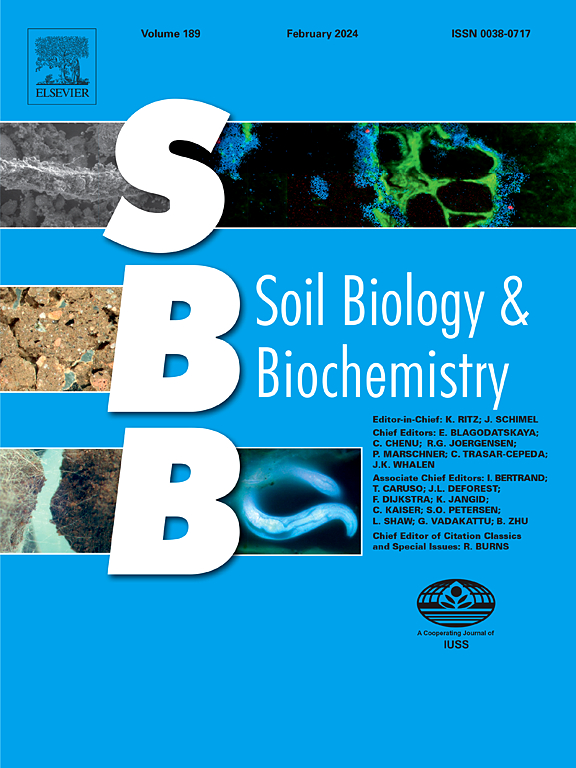Potential viral influence on sulfur metabolism in acid sulfate soils
IF 9.8
1区 农林科学
Q1 SOIL SCIENCE
引用次数: 0
Abstract
Acid sulfate soils cover extensive areas across the globe and pose profound ecological and economic challenges. While microbial activities associated with sulfur metabolisms primarily mediate the formation process of acid sulfate soils, the potential impact of viruses, known for their roles in infecting microorganisms or encoding auxiliary metabolic genes (AMGs), remains largely unexplored. Here, we characterized the community and biogeochemical impacts of viruses in unoxidized acid sulfate soils (hypersulfidic soils, pH 6.5–7.3) and oxidized acid sulfate soils (sulfuric soils, pH < 3.3) using paired viromes and total metagenomes. Our results revealed higher diversity and distinct composition of viral communities in hypersulfidic soils compared to sulfuric soils. In hypersulfidic soils, we identified 30 times more virus-encoded AMGs and observed an average abundance 6.6 times higher than in sulfuric soils. Particularly, the identification of AMGs associated with assimilatory and dissimilatory sulfate reduction, organosulfur compound degradation, organic matter degradation, and electron transfer implied the potential role of viruses in influencing sulfur cycling and the formation of sulfidic materials in Hypersulfidic soils. The virus-host predictions linked seven lysogenic and 55 lytic vOTUs to sulfate-reducing and sulfur-oxidizing microorganisms in both soils, suggesting that viruses play a role in sulfur cycling through host infection. Altogether, our findings highlight the potential roles of viruses in influencing sulfur cycling processes in acid sulfate soils.
病毒对酸性硫酸盐土壤硫代谢的潜在影响
酸性硫酸盐土壤覆盖全球广泛地区,并带来深刻的生态和经济挑战。虽然与硫代谢相关的微生物活动主要介导酸性硫酸盐土壤的形成过程,但已知病毒在感染微生物或编码辅助代谢基因(AMGs)方面的作用,其潜在影响在很大程度上仍未被探索。本文研究了病毒在未氧化硫酸酸性土壤(高硫土壤,pH 6.5 ~ 7.3)和氧化硫酸酸性土壤(硫酸土壤,pH <;3.3)使用配对的病毒组和总宏基因组。结果表明,与硫土壤相比,高硫土壤中病毒群落具有更高的多样性和独特的组成。在高硫土壤中,我们发现了30倍以上的病毒编码AMGs,并且观察到平均丰度比硫土壤高6.6倍。特别是,与同化和异化硫酸盐还原、有机硫化合物降解、有机物降解和电子转移相关的AMGs的鉴定暗示了病毒在影响高硫土壤中硫循环和硫物质形成方面的潜在作用。病毒-宿主预测将两种土壤中的7个溶原性和55个溶解性votu与硫酸盐还原和硫氧化微生物联系起来,表明病毒通过宿主感染在硫循环中发挥作用。总之,我们的发现强调了病毒在影响酸性硫酸盐土壤中硫循环过程中的潜在作用。
本文章由计算机程序翻译,如有差异,请以英文原文为准。
求助全文
约1分钟内获得全文
求助全文
来源期刊

Soil Biology & Biochemistry
农林科学-土壤科学
CiteScore
16.90
自引率
9.30%
发文量
312
审稿时长
49 days
期刊介绍:
Soil Biology & Biochemistry publishes original research articles of international significance focusing on biological processes in soil and their applications to soil and environmental quality. Major topics include the ecology and biochemical processes of soil organisms, their effects on the environment, and interactions with plants. The journal also welcomes state-of-the-art reviews and discussions on contemporary research in soil biology and biochemistry.
 求助内容:
求助内容: 应助结果提醒方式:
应助结果提醒方式:


